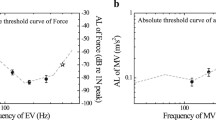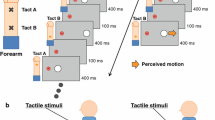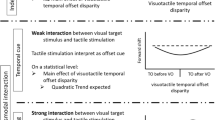Abstract
Vibratory stimulation of the neck muscles can elicit illusory drift of a visual target; after vibration stops, motion in the opposite direction is perceived. This motion aftereffect (MAE) could be due to adaptation of proprioceptive mechanisms that encode head orientation, or at a stage where visual and proprioceptive information are combined. To distinguish between these two possibilities, we applied vibratory stimulation to dorsolateral neck muscles for 15-s periods alternating with 15-s periods without vibration. Twenty-six observers used a hand-held tracker to indicate perceived motion of a stationary light-emitting diode (LED) in an otherwise dark room. In the critical condition, observers were in complete darkness during vibration, and the LED was only turned on in post-vibration periods. If adaptation was purely proprioceptive, a visual MAE should have occurred in this condition, but it did not. In a follow-up experiment (N = 9), the LED was presented intermittently to determine if there was a position aftereffect that might have been inhibited by processes signalling an absence of motion. No aftereffect occurred under these conditions either. In both experiments, a visual stimulus had to be present during the adaptation period in order to elicit an aftereffect. Results from our previous study ruled out an explanation based on suppression of eye movements. Thus, the most likely site responsible for the visual aftereffect lies with bimodal mechanisms combining proprioceptive and visual information. We conclude that the bimodal mechanisms adapted more quickly than the proprioceptive mechanisms from which they received input.










Similar content being viewed by others
References
Addams R (1834) An account of peculiar optical phenomenon seen after having looked at a moving body. Lond Edinburgh Philos Mag J Sci 5:373–374
Biguer B, Donaldson I, Hein A, Jeannerod M (1988) Neck muscle vibration modifies the representation of visual motion and direction in man. Brain 111:1405–1424
Burke D, Hagbarth K, Lofstedt L, Wallin B (1976) The responses of human muscle spindle endings to vibration during isometric contraction. J Physiol 261:695–711
Donaldson IM (2000) The functions of the proprioceptors of the eye muscles. Philos Trans R Soc Lond B 355:1685–1754
Duffy C, Page W, Froehler M (2005) Posterior cortical processing of self-movement cues: MSTd’s role in Papez’ circuit for navigation. In: Wiener S, Taube J (eds) Head direction cells and the neural mechanisms of spatial orientation. A Bradford Book. MIT Press, Cambridge
Goodwin G, McCloskey D, Matthews P (1972) The contribution of muscle afferents to kinaesthesia shown by vibration induced illusions of movement and by the effects of paralysing joint afferents. Brain 95:705–748
Graybiel A, Hupp D (1946) The oculo-gyral illusion. J Aviat Med 3:1–12
Harris L (1994) Visual motion caused by movements of the eye, head and body. In: Smith A, Snowden R (eds) Motion detection: an overview. Academic, London, pp 397–436
Helson H (1948) Adaptation-level as a basis for a quantitative theory of frames of reference. Psychol Rev 55:297–313
Howard I (1997) Interactions within and between the spatial senses. J Vestib Res 7(4):311–345
Karnath H-O, Reich E, Rorden C, Fetter M, Driver J (2002) The perception of body orientation after neck-proprioceptive stimulation. Exp Brain Res 143:350–358
Lackner J, Levine M (1979) Changes in apparent body orientation and sensory localization induced by vibration of postural muscles: vibratory myesthetic illusions. Aviat Space Environ Med 50:346–354
Lennerstrand G, Han Y, Velay J-L (1996) Properties of eye movements induced by activation of neck muscle proprioceptors. Graefes Arch Clin Exp Opthalmol 234:703–709
Levy J (1972) Autokinetic illusion: a systematic review of theories, measures and independent variables. Psychol Bull 78:457–474
Lewald J, Karnath H-O, Ehrenstein W (1999) Neck-proprioceptive influence on auditory lateralization. Exp Brain Res 125:389–396
Mather G, Verstraten F, Anstis S (1998) The motion aftereffect. A Bradford Book. MIT Press, Cambridge
McCloskey DI (1973) Differences between the senses of movement and position shown by the effects of loading and vibration of muscles in man. Brain Res Bull 63:119–131
Mergner T, Scweigart G, Botti F, Lehmann A (1998) Eye movements evoked by proprioceptive stimulation along the body axis in humans. Exp Brain Res 120:450–460
Morgan C (1978) Constancy of egocentric visual direction. Percept Psychophys 23:61–68
Popov K, Lekhel H, Faldon M, Bronstein A, Gresty M (1999) Visual and oculomotor responses induced by neck vibration in normal subjects and labyrinthine-defective patients. Experimental Brain Res 128:343–352
Purkinje J (1825) Beobachtungen und Versuche zur Physiologie dr Sinne. Neue Beitrage zur Kenntniss des Sehens in Subjectiver Hindsicht. Reimer, Berlin
Ribot-Ciscar E, Roll JP (1998) Ago-antagonist muscle spindle inputs contribute together to joint movement coding in man. Brain Res 791:167–176
Ribot-Ciscar E, Rossi-Durand C, Roll JP (1998) Muscle spindle activity following muscle tendon vibration in man. Neurosci Lett 258:147–150
Roll JP, Roll R (1987) Kinaesthetic and motor effects of extraocular muscle vibration in man. In: O’Regan JK, Levy-Schoen A (eds) Eye movements: from physiology to cognition. Elsevier Sciences Publishers, Amsterdam, pp 57–68
Roll JP, Roll R (1988) From eye to foot: a proprioceptive chain involved in postural control. In: Amblard B, Berthoz A, Clarac F (eds) Posture and gait: development, adaptation and modulation. Excerpta Medica, Amsterdam, pp 155–164
Roll JP, Roll R, Velay J-L (1991) Proprioception as a link between body space and extra-personal space. Brain and space, Oxford University Press, pp 112–132
Seizova-Cajic T, Sachtler WLB, Curthoys IS (2006) Eye movements cannot explain vibration-induced visual motion and motion aftereffect. Exp Brain Res 173:141–152
Snyder LH, Grieve KL, Brotchie P, Andersen RA (1998) Separate body- and world-referenced representations of visual space in parietal cortex. Nature 394:887–891
Taylor JL, McCloskey D (1991) Illusions of head and visual target displacement induced by vibration of neck muscles. Brain 114:755–759
Wade NJ (1998) A natural history of vision. MIT, Cambridge
Wierzbicka M, Gilhodes JC, Roll JP (1998) Vibration-induced postural posteffects. J Neurophysiol 79:143–150
Wohlgemuth A (1911) On the after-effect of seen movement. Br J Psychol Mon Suppl 1:1–117
Acknowledgements
We thank Ian Curthoys for helpful discussions and use of equipment, and Nenad Petkovski for software development. This work was supported by a University of Sydney SESQUI grant.
Author information
Authors and Affiliations
Corresponding author
Appendix
Appendix
Eye movements
Throughout the history of vision research, eye movements have been proposed to explain various motion illusions: the classical motion aftereffect (Purkinje 1825; Addams 1834; quoted in Wade 1998, p. 213–214), the oculogyral illusion (Graybiel and Hupp 1946), the autokinetic effect (see review by Levy 1972), and the illusion that is the topic of the present study (Popov et al. 1999). The crucial element in these explanations is the idea that the brain does not register involuntary or reflex eye movements, but does register the retinal slip of images arising from these eye movements. It is also assumed that the brain registers the commands issued to the extraocular muscles to pursue the target or to maintain fixation countering the reflex tendencies, interpreting them as eye movement even if the eye remains stationary.
Of the various motion illusions to which eye movement explanations were applied, the one most similar to the illusion presently discussed is the oculogyral illusion that occurs in response to vestibular stimulation. Vestibular stimulation is similar to neck-proprioceptive stimulation in that they both indicate head rotation and trigger reflex eye movements. However, unlike the vestibulo-ocular reflex, reflex eye movements triggered by proprioceptive input from the neck—such as those elicited by rotating the trunk relative to the stationary head (the cervico-ocular reflex)—are not necessarily compensatory in sign relative to the direction of head movement: for some velocities, they are actually anticompensatory, moving in the same direction as the head (Mergner et al. 1998). These eye movements are also much more variable in terms of direction across subjects than eye movements triggered by vestibular stimulation (see Fig. 3 in Mergner et al. 1998).
The eye movements elicited by vibratory stimulation of the neck muscles are also variable and therefore they are often inconsistent with the direction of illusory visual motion, which is more uniform across subjects. Similarly, eye movements that occur after adaptation through neck muscle vibration are often inconsistent with the perceived motion aftereffect (Lackner and Levine 1979; Seizova-Cajic et al. 2006). These findings are incompatible with the idea that eye movements or oculomotor commands cause the aftereffects. Details of a possible explanation of the aftereffect based on oculomotor commands are described below.
Since neck muscle vibration elicits eye movements that are suppressed when a fixation target is present, it is possible that, when vibration stops, the aftereffect of the suppression signal may be interpreted as image motion, leading to a visual aftereffect (a similar explanation was proposed in relation to the autokinetic effect that occurs following a prolonged extreme eye turn; see Levy 1972, for a review). The absence of an aftereffect in the Dark–Dot condition would thus be explained by the absence of a suppression signal during vibratory stimulation since there was no fixation target (as suggested by an anonymous reviewer). However, in our previous study (Seizova-Cajic et al. 2006) we also presented evidence that argues against the suppression signal as the cause of the aftereffect. In the remaining part of this Appendix, we clarify our method to infer the direction encoded by oculomotor commands that might suppress eye movements in the presence of a fixation target, and re-analyze data from our previous study to determine whether such motor commands could explain the aftereffect.
Although the eye movements suppressed during fixation can obviously not be measured directly, we might reasonably assume that the eye movements exhibited in the absence of a fixation target are the ones that are suppressed in the presence of a fixation target. From this information, the direction of the suppression command can be inferred and compared to the direction of illusory motion during the aftereffect.
To test the suppression explanation, we re-analyzed results from our previous study which included measurement of eye movements during neck muscle vibration in darkness as well as the direction of illusory motion after vibration in the presence of a fixation target. The methods and analysis were very similar to those described in the current study, with variations in the placement of vibrators. The top row of Fig. 11 shows results for vibrators applied simultaneously to the left and right SCM muscles, while the bottom row shows results for a single vibrator placed against the right posterior region of the neck, stimulating primarily splenius capitis and possibly the SCM. Results are shown for participants for whom both eye movements and illusory motion were significantly different from zero (taken from Figs. 7, 8 in Seizova-Cajic et al. 2006; eye movements are taken from the third column in each of the original figures, where they were shown as black lines, and pointing data is from the first column, shown there as grey lines).
(Appendix). Comparison of motion aftereffect to eye movements during neck muscle vibration in the dark. Test of hypothesis that motion aftereffect is caused by an aftereffect of suppressed eye movements. Data are taken from Figs. 7, 8 in Seizova-Cajic et al (2006); see text for details. The top row shows results for vibration applied simultaneously to SCM muscles on both sides of the neck and the bottom row for vibration applied to splenius capitis on the right side of neck. Black lines show direction of the motion aftereffect following adaptation in the presence of a fixation target (pointing data). Grey lines show direction of cumulative slow-phase eye movements during vibration in complete darkness. Note that the scale for eye movements differs from the scale for pointing movements indicated on the axes for all participants except SG: for participants CB, JO, and TSC, eye movements have been multiplied by 1/2, and by 2 for JP
For all participants, and for both stimulation sites, the direction of the motion aftereffect following neck muscle vibration in the presence of a fixation target was predominantly downward, as indicated by the solid black lines in Fig. 11. The grey lines show the cumulative slow-phase eye movements recorded during neck muscle vibration in the dark (see Seizova-Cajic et al. 2006, for details). For JP, and somewhat less so for TSC, these eye movements in the dark are roughly in the same direction as the aftereffect, as predicted by the suppression account. However, the direction of eye movements differs by about 45° from the direction of illusory motion for SG, by almost 90° for CB, and by more than 90° for JO.
This extensive variation between the direction of eye movements in the dark and the direction of illusory motion is incompatible with a causal relationship. We can thus rule out the suppression motor command as the main cause of the motion aftereffect. By a similar account, we showed in our previous study that eye movements suppressed during the test phase fail to explain the aftereffect. Overall, eye movements concurrent with the illusion and aftereffect, as well as imputed oculomotor commands, vary greatly in direction, and thus fail to explain the visual phenomena, which are quite consistent.
Rights and permissions
About this article
Cite this article
Seizova-Cajic, T., Sachtler, W.L.B. Adaptation of a bimodal integration stage: visual input needed during neck muscle vibration to elicit a motion aftereffect. Exp Brain Res 181, 117–129 (2007). https://doi.org/10.1007/s00221-007-0910-7
Received:
Accepted:
Published:
Issue Date:
DOI: https://doi.org/10.1007/s00221-007-0910-7





